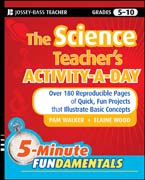
The science teacher's activity-a-day, grades 5-10: over 180 reproducible pages of quick, fun projects that illustrate basic concepts
Walker, Pam
Wood, Elaine
INDICE: About This Book. About the Authors. Correlations of Activities to the National Science Content Standards. UNIT I PHYSICAL SCIENCE. Section 1: Organization of Matter. 1.1 Boyles Gas Law: Marshmallow Under Pressure. 1.2 Buoyancy: Ketchup Packet Cartesian Divers. 1.3 Counting Molecules and Atoms: Numberof Molecules of Chalk in Your Signature. 1.4 Identifying and Naming Isotopes:EggCeptional Isotopes. 1.5 Chemical and Physical Changes: Examining Paper forChange. 1.6 Physical Properties of Matter: Tootsie Roll Properties. 1.7 Density: Cant Hold a Good Ping-Pong Ball Down. 1.8 Atomic Size in Picometers: Cutting Paper to Atom Size. 1.9 Surface Tension: Why Some Insects Can Walk on Water. 1.10 Birds in Flight: How Birds Wings Enable Them to Fly. 1.11 Mendeleevs Periodic Table: It Was All in the Cards. 1.12 Volume of a Cylinder: The Long andShort of Volume. Section 2: Interactions of Matter. 2.1 Acids and Bases: Cabbage Juice Indicators. 2.2 Polymers: Water-Loving Chemicals in Diapers. 2.3 Freezing Point: Why We Sprinkle Salt on Icy Roads. 2.4 Exothermic and EndothermicReactions: Hot Packs and Cold Packs. 2.5 Chemical Reactions: Alka-Seltzer andWater Temperature. 2.6 Balancing Chemical Equations: Rearranging Atomic Dots.2.7 Limiting Reactants: Putting a Halt to the Reaction. 2.8 Writing Ionic Formulas: Equating the Ions. 2.9 Single Replacement Reactions: Turning Iron into Copper. 2.10 Double Replacement Reactions: Trading Partners. 2.11 Polarity andSolubility: Breaking Bonds of Packing Peanuts. 2.12 Surface Area and Solubility: Sweet Solutions. Section 3: Energy of Motion. 3.1 Potential Energy and Kinetic Energy: Bouncing Golf Balls. 3.2 Potential Energy: The Energy of Falling Objects. 3.3 Friction Through a Fluid: Fluids and Falling. 3.4 Newtons First Law of Motion: Inertiathe Magicians Friend. 3.5 Law of Conservation of Momentum: Marble Collisions. 3.6 Static Friction: Going Against the Grain. 3.7 NewtonsSecond Law of Motion: Acceleration of the Coffee Mug. 3.8 Using the Speed Formula: Speedy Manipulations. 3.9 Newtons Third Law of Motion: What Is a Reaction? 3.10 Inclined Planes: Making Lifting Easier. 3.11 Levers: First-Class Machines. 3.12 The Three Classes of Levers: Lots of Levers and Lots of Class. Section 4: Heat, Light, and Sound Waves. 4.1 Thermal Energy: What Does Temperature Really Measure? 4.2 Measuring Temperature: Human Thermometers. 4.3 Refraction:A Real Light Bender. 4.4 Concave and Convex Mirrors: An Up-Close Look at the Spoon. 4.5 Magnifying Lens: Water Drop Microscopes. 4.6 Mechanical Waves: The Stadium Wave. 4.7 Transverse Waves: Anatomy of a String Wave. 4.8 Compressional Waves: Making Waves with a Slinky. 4.9 Sound and Its Mediums: Sound Matters.4.10 Sound Vibrations: Rubber Band Music. 4.11 Sound and Water: Tuning Forks and Water. 4.12 Energy Conductors and Insulators: The Cooks Choice. Section 5:Magnetism an
- ISBN: 978-0-470-40881-0
- Editorial: John Wiley & Sons
- Encuadernacion: Rústica
- Páginas: 288
- Fecha Publicación: 22/10/2010
- Nº Volúmenes: 1
- Idioma: Inglés
